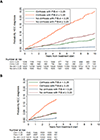Increased Risk for Hepatocellular Carcinoma Persists Up to 10 Years After HCV Eradication in Patients With Baseline Cirrhosis or High FIB-4 Scores
- PMID: 31356807
- PMCID: PMC6815714
- DOI: 10.1053/j.gastro.2019.07.033
Increased Risk for Hepatocellular Carcinoma Persists Up to 10 Years After HCV Eradication in Patients With Baseline Cirrhosis or High FIB-4 Scores
Abstract
Background & aims: It is unclear if hepatocellular carcinoma (HCC) risk declines over time after hepatitis C virus (HCV) eradication. We analyzed changes in HCC annual incidence over time following HCV eradication and identified dynamic markers of HCC risk.
Methods: We identified 48,135 patients who initiated HCV antiviral treatment from 2000 through 2015 and achieved a sustained virologic response (SVR) in the Veterans Health Administration (29,033 treated with direct-acting antiviral [DAA] agents and 19,102 treated with interferon-based regimens). Patients were followed after treatment until February 14, 2019 (average 5.4 years), during which 1509 incident HCCs were identified.
Results: Among patients with cirrhosis before treatment with DAAs (n = 9784), those with pre-SVR fibrosis-4 (FIB-4) scores ≥3.25 had a higher annual incidence of HCC (3.66%/year) than those with FIB-4 scores <3.25 (1.16%/year) (adjusted hazard ratio 2.14; 95% confidence interval 1.66-2.75). In DAA-treated patients with cirrhosis and FIB-4 scores ≥3.25, annual HCC risk decreased from 3.8%/year in the first year after SVR to 2.4%/year by the fourth year (P=.01). In interferon-treated patients with FIB-4 scores ≥3.25, annual HCC risk remained above 2%/year, even 10 years after SVR. A decrease in FIB-4 scores from ≥3.25 pre-SVR to <3.25 post-SVR was associated with an approximately 50% lower risk of HCC, but the absolute annual risk remained above 2%/year. Patients without cirrhosis before treatment (n = 38,351) had a low risk of HCC, except for those with pre-SVR FIB-4 scores ≥3.25 (HCC risk 1.22%/year) and post-SVR FIB-4 scores ≥3.25 (HCC risk 2.39%/year); risk remained high for many years after SVR.
Conclusions: Patients with cirrhosis before an SVR to treatment for HCV infection continue to have a high risk for HCC (>2%/year) for many years, even if their FIB-4 score decreases, and should continue surveillance. Patients without cirrhosis but with FIB-4 scores ≥3.25 have a high enough risk to merit HCC surveillance, especially if FIB-4 remains ≥3.25 post-SVR.
Keywords: Liver Cancer; Long-Term Outcome; Population; Prognostic Factor.
Copyright © 2019 AGA Institute. Published by Elsevier Inc. All rights reserved.
Figures



Comment in
-
Incidence of hepatocellular carcinoma after HCV eradication: assessing the risk.Hepatobiliary Surg Nutr. 2020 Apr;9(2):255-256. doi: 10.21037/hbsn.2019.10.17. Hepatobiliary Surg Nutr. 2020. PMID: 32355696 Free PMC article. No abstract available.
-
Risk stratification of HCC occurrence after HCV eradication: a complicate plot of risk factors related and unrelated to the previous viral disease.Hepatobiliary Surg Nutr. 2020 Aug;9(4):511-513. doi: 10.21037/hbsn.2019.11.27. Hepatobiliary Surg Nutr. 2020. PMID: 32832506 Free PMC article. No abstract available.
-
FIB-4 score and hepatocellular carcinoma risk after hepatitis C virus cure: time to revise surveillance?Hepatobiliary Surg Nutr. 2020 Oct;9(5):661-664. doi: 10.21037/hbsn.2020.01.05. Hepatobiliary Surg Nutr. 2020. PMID: 33163519 Free PMC article. No abstract available.
References
-
- Morgan RL, Baack B, Smith BD, et al. Eradication of hepatitis C virus infection and the development of hepatocellular carcinoma: a meta-analysis of observational studies. Ann Intern Med 2013;158:329–37. - PubMed
-
- Singal AK, Singh A, Jaganmohan S, et al. Antiviral therapy reduces risk of hepatocellular carcinoma in patients with hepatitis C virus-related cirrhosis. Clin Gastroenterol Hepatol 2010;8:192–9. - PubMed
-
- Kanwal F, Kramer J, Asch SM, et al. Risk of Hepatocellular Cancer in HCV Patients Treated With Direct-Acting Antiviral Agents. Gastroenterology 2017;153:996–1005 e1. - PubMed
-
- Singer AW, Reddy KR, Telep LE, et al. Direct-acting antiviral treatment for hepatitis C virus infection and risk of incident liver cancer: a retrospective cohort study. Aliment Pharmacol Ther 2018. - PubMed
Publication types
MeSH terms
Substances
Grants and funding
LinkOut - more resources
Full Text Sources
Medical

